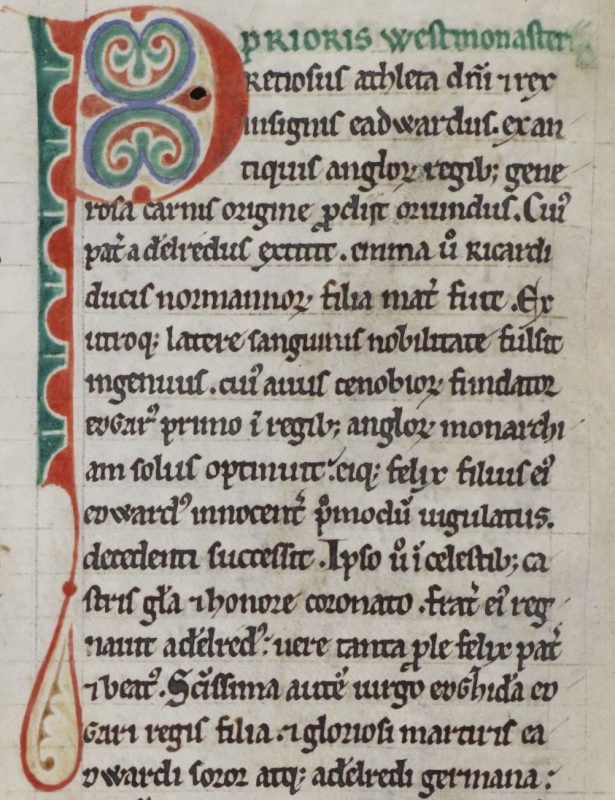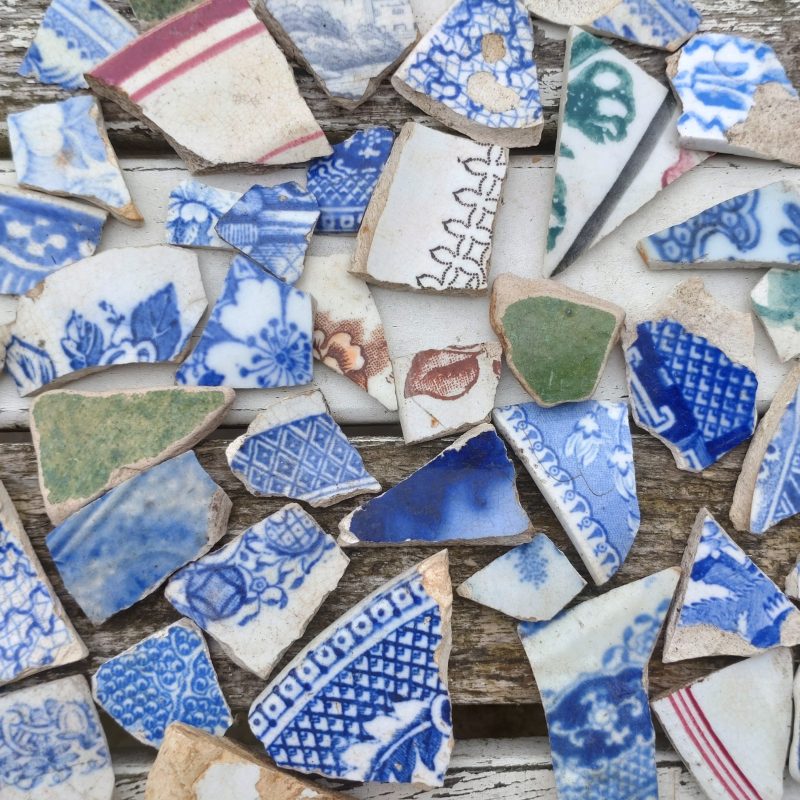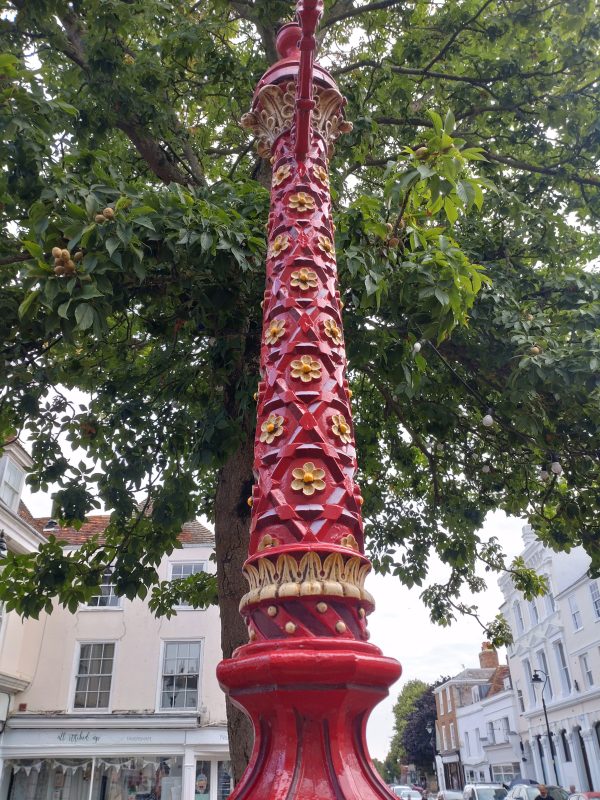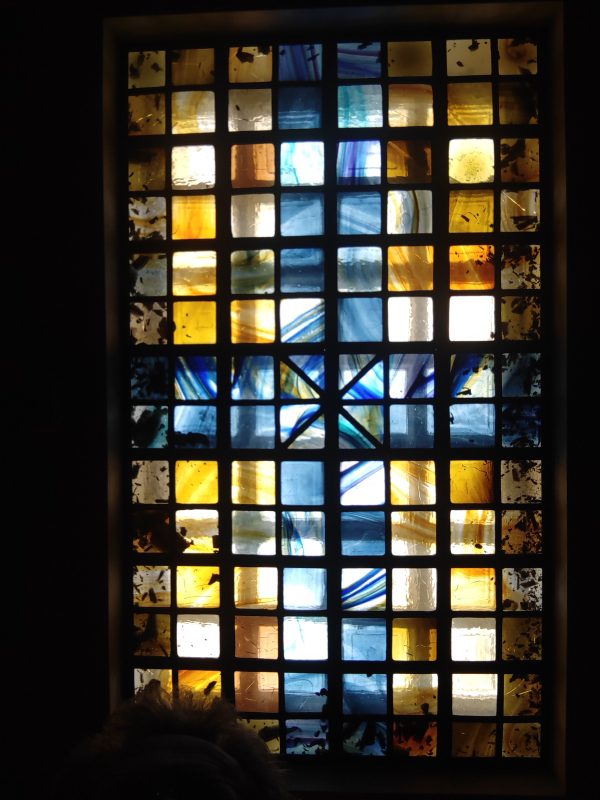Words Justin Croft Photographs Various
Our notebooks are bulging with words and our phones and laptops are stuffed with photos. Some we’ve used for articles, some we haven’t. It’s time for an annual tidy.
I for one have been scrolling through my camera roll of Faversham pictures. I see there’s a pattern. It might even be an obsession. An obsession with ornament. It seems I can’t resist taking photos of ornamental details from buildings, artefacts and documents. Sometimes I sneak one into a Faversham Life article, but mostly they sit in my phone with their garish pixels clogging up the memory card. Before I delete them I thought it would be fun to share some more.

Illuminated decoration made around the year 1200 from a manuscript possibly made for Faversham Abbey. Parker Library, Corpus Christi College, Cambridge MS 161
Some time ago I wrote about Faversham Abbey and its medieval books. I was excited to find that one of the books possibly survived in a library in Cambridge and I downloaded a sheaf of glorious illuminated letters like the one above. The letter ‘P’ is especially fun with its neat infill looking like a pair of crisp multicoloured palmier biscuits.
But you don’t have to go to Cambridge if you like medieval illumination. We have some here in town. At very top of of my top-ten Faversham ornaments is the fabulous decoration on the Henry IV charter, on permanent display in the Magna Carta exhibition at 12 Market Place.

Illumination with ink, pigments and burnished gold on parchment. Faversham’s charter of 1408, issued by Henry IV. On display with the Magna Carta at 12 Market Place.
I love the way the letter ‘H’ for Henry is extended with extravagant scrolls of leaves and tendrils, and the whole thing set off with burnished gold. It looks even better under the dramatic low light of the exhibition. It was probably made at Westminster, by the expert teams of scribes and illuminators working there in the fifteenth century. It’s of the highest quality and, in decorative terms, is as a good as anything you’ll see in the great libraries of the nation.

Blue and white. Humble pot sherds dug up on the Stonebridge allotment
My next photo is rubbish. Literally. Another of my small obsessions is picking up pot fragments wherever I find them. Perhaps some of you do the same. These fragments have all come out of my allotment at Stonebridge Pond over the past few years. I love the variety of patterns here, almost every fragment with some variation on the familiar themes of Victorian transferware.
For me, ornament is one of the the things that makes life fun. Of course we can (and do) drink out of plain china mugs, but there’s a special pleasure in a well-decorated cup. We don’t really need ornament, but throughout history it seems to be one of the things that makes us human. Taking pleasure in what, on the face of it, seems unnecessary.

Sunflowers! Moulded and cut brick panels are everywhere in Faversham. Presumably designed to mix and match designs.
Faversham is not unique in the way its buildings are decorated, but we do have some especially fine examples of Victorian ornament, partly the result of the town’s brick industry. For the observant, a walk through the Victorian and Edwardian parts of the town can be a masterclass in ornament. I wonder if anyone has documented all the delightful brick panels on the house frontages? It would make a great project, with a camera, or even better, a pencil and paper. There is so much inspiration to be found in these details we walk past every day. Only the other day I noticed for the first time the amazing cut brick details of hop bines adorning the frontage of the old Nat West bank in the market place. The shiny signage for the newly opened Leo Lounge there drew my eye to the brick ornaments above. Not easy to photograph, so go and have a look!

A winged female caryatid sailing down Preston Street almost engulfed by scrolling ornaments.
Of course, the Victorians and Edwardians were passionate ornamenters. Sometimes their zeal got out of hand. I’ve always thought the Faversham market pump an example of ornament gone bonkers. A simple pump and lamp post arrangement has morphed into a crazy barleytwist hotchpotch. Victorian designers often used handbooks like Owen Jones’s handsome Grammar of Ornament published in 1856. Whoever designed our pump seems to have ransacked one of these guides with scissors and paste. I love it, but I know it’s mad.

Faversham’s cast iron pump, installed in 1855, with its elaborate floral column, which originally doubled as a gas lamp
It’s probably this kind of design which gave ornament a bad name. As we know, not everyone was a fan, with people like Oscar Wilde commenting ‘Let us have no machine-made ornament at all; it is all bad and worthless and ugly’ and John Ruskin and William Morris insisting too on ornament made only by hand.
The modernists of the twentieth century were even more suspicious and some of them would have done away with ornament altogether. The influential architect Adolf Loos wrote an article in 1908 called ‘Ornament and Crime’ in which he criticized useless decoration on useful objects (like buildings) and we know how sparse some of the buildings of the early twentieth century could be. We don’t have too many modernist buildings here in Faversham, but I’ve always admired the sleek white form of the 1940s BMM Weston building above the town beside Davington manor. I’m no expert but I think it’s a fine contrast to some of the ornamental extravagances in the town below.

Classical modernism. Restrained but stylish hoop ornaments for the window light above the door of the Saxon Road telephone exchange, 1938
Modernism never did dispense with ornament entirely but it did make it more restrained. Has anyone noticed the elegant hoop motifs in the door light of the Saxon Road telephone exchange? The panel works well with the stark neo-classical architraves of the doorway and is worth preserving. The building seems to be almost criminally neglected by its custodians, though its roof has recently been patched and the neo-Georgian upper windows replaced with what looks like plastic double glazing.

Modern geometric stained glass panel, a colourful ceiling light at the Shrine of St Jude, Tanner’s Street
Today, we may not be decorating like our medieval and Victorian ancestors, but I don’t think ornament is at any risk of dying out. A recent visit to the shrine of St Jude in Tanner’s street revealed a delightful array of modern ornament in an international style. There are recent wall paintings (not just the well-known Ardizzone ones), ceramic mouldings and stained glass, all well worth a look.
So while I delete my ornamental images over the summer, do go and take some of your own pictures of the hundreds of decorative delights in Faversham. Wishing all our readers a summer of discovery and see you in September!